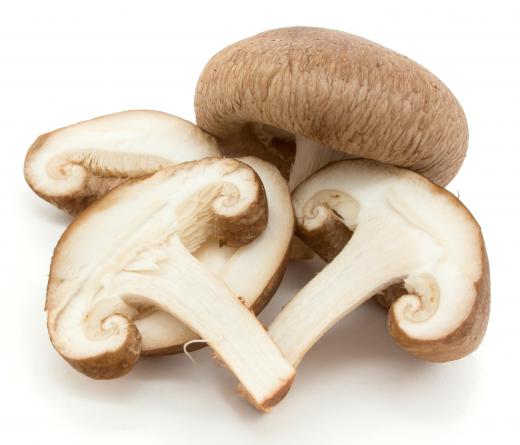What are Fungi?
 Michael Anissimov
Michael Anissimov
Fungi are a kingdom of eukaryotic (their cells have nuclei) organisms. Other examples of biological kingdoms include Plantae, the plants, and Animalia, the animals. Common fungi include mushrooms, yeasts, and molds. Fungi are essential in decomposing dead organic matter in the soil, and without them, biological refuse would take much longer to degrade, making it difficult for the next generation of organisms to utilize the essential elements therein. Although fungi may look like plants, they are in fact more closely related to animals. The study of mushrooms is known as mycology.
The key characteristic of fungi which sets them apart from other organisms are their chitinous cell walls. This durable material, chitin, also makes up the shells of many insects. Fungi tend to grow in filamentous structures known as mycelium, and reproduce either sexually or asexually via spores. In mushrooms, the spores are visible as black dust underneath the cap.

Fungi have a long history of being utilized by humans. Yeasts are used to give bread the puffy consistency with which we are familiar. Many mushrooms are integrated into dishes; the Portobello mushroom is one of the more popular species. Some fungal species are critical to fermentation, the process underlying the production of alcoholic beverages. Cheeses possess their characteristic odd smell, and sometimes, color, due to carefully introduced fungi. Psilocybin mushrooms have long been consumed for their hallucinogenic properties. Some species of mushrooms with creative names such as “destroying angel” and “death cap” are very poisonous, however, and can cause death within hours of consumption.
In an effort to cut down on the use of chemically polluting pesticides, some agricultural scientists have developed fungi for use as biopesticides – beneficial fungi which produce alkaloids toxic to a wide range of insects and other pests.

Fungi can be found in every environment on Earth, even the dry valleys of Antarctica, where small microbial populations exist during the summer. Fungi exist in pretty much every square meter of the Earth’s surface that is not permanently frozen or thoroughly sterilized. The only way to restrict fungal growth is by using a refrigerator or freezer.
AS FEATURED ON:
AS FEATURED ON:















Discussion Comments
As far as examples of fungi go, let's not forget that fungus doesn't have to be deadly to be bad for you! Case in point: toenail fungus. Yucky, not at all comfortable, and definitely considered part of the fungi family.
On a side note, I think it's funny how so many people think that algae is fungi. It isn't -- algae is tiny, tiny plants that grow together in a bit group, while fungi is living fungus organisms as we can read here on WiseGEEK. Since algae looks so smooth and grows over things similar to fungi, though, I can see how somebody could make the mistake of thinking they're the same thing.
@anon154865 - Hey, there. Since malmal came up with only really freaky-sounding mushrooms for types of fungi, I figured I'd put in my two cents.
The most commonly known kind of fungus, for most people, is mushrooms. There are lots of ones that are perfectly safe to eat and really tasty, so don't let the reports of scary poisonous ones throw you off -- just let a professional do the picking!
As for other kinds of fungi, one fungus that people swear up and down is great for health benefits is the kombucha "mushroom". Kombucha's less a mushroom and more a gelatinous blob that floats in a bottle of tea, growing and staying alive there in a culture of bacteria.
I'm a bit sketchy on whether it's actually fungi or if they're just what everyone thinks since they refer to it as a mushroom constantly, but I figured it was worth mentioning.
Kombucha, like yogurt, is a great way to introduce good digestive bacteria into your body, and promotes a healthy digestive system. It's also apparently filled with lots of antioxidants, from what I've read. I want to try it someday, myself.
@anon154865 - There are literally thousands of different kinds of fungi out there, and they range from deadly poison to great for your health. The deadly ones are the ones I know by heart; here are a few:
Death Cap Mushroom: The most common cause of mushroom poisoning in the United States, the Death Cap is white with a yellowish cap and looks pretty normal, so people don't realize that it's so toxic it will literally melt your liver and kill you if you eat even a tiny bite of it.
Death Angel Mushroom: Found in California and the Pacific Northwest, this mushroom grows near Oak trees a lot, and it causes organ failure and death. The Death Angel mushroom looks like a slender white toadstool with fine feathery texture under the flat cap that can be slightly yellowish.
Sulfur Tuft Mushroom: A yellow rounded mushroom that grows in clusters of many at a time. The Sulfur Tuft mushroom causes convulsions, diarrhea, vomiting, and can cause organ failure and paralysis, if not death.
These are some of the most deadly mushrooms in the world. I hear there are healthy mushrooms, but reading about the deadly ones is more fun for me!
what are the different harmful and beneficial fungi?
I think a more precise description of fungi may need to involve all the basic features.
Fungi can be described as plants without chlorophyll. There are different types of fungi. Some are beneficial, even edible like mushrooms, while others can cause trouble.
Post your comments